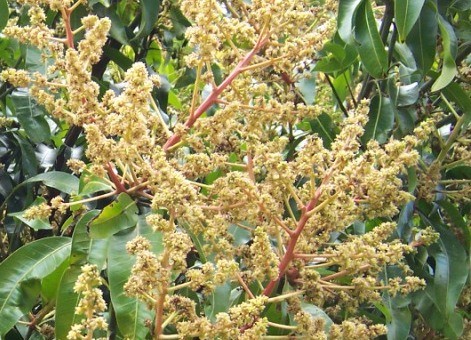Indian mango
(Mangifera foetida)

Description
Mangifera indica, commonly known as mango, is a species of flowering plant in the family Anacardiaceae. Mangoes are believed to have originated from the region between northwestern Myanmar, Bangladesh, and India. It is a large fruit-tree, capable of growing to a height and crown width of about 30 metres (100 ft) and trunk circumference of more than 3.7 metres (12 ft). It is a large green tree, valued mainly for its fruits, both green and ripe. Approximately 500 varieties of mango have been reported in India. It can grow up to 15–30 metres (49–98 ft) tall. The tree grows best in well-drained sandy loam; it does not grow well in heavy wet soils. The optimal pH of the soil should be between 5.2 and 7.5. Red-yellow flowers appear at the end of winter and beginning of spring. Both male and female flowers are borne on same tree. The Climatic conditions have significant influence on the time of flowering of mango. In India, flowering starts in December in the South, in January in Bihar and Bengal, in February in eastern Uttar Pradesh, and in February–March in northern India. The duration of flowering is 20–25 days in Dashehari, while panicle emergence occurs in early December and flower opening is completed by February. The Neelum variety of mango produces two crops a year in Kanyakumari, in South India, but it flowers only once in North Indian conditions. The mango is an irregular, egg-shaped fruit which is a fleshy drupe. Mangos are typically 8–12 cm (3–5 in) long and greenish yellow in color. The fruits can be round, oval, heart, or kidney shaped. Mango fruits are green when they are unripe. The interior flesh is bright orange and soft with a large, flat pit in the middle. Mangos are mature in April and May. Raw mangos can be used in the making of pickles and chutneys. Ripe mangos are a popular fruit throughout the world. The skin and pulp account for 85% of the mango's weight, and the remaining 15% comes from the stone (seed). Mangiferin (a pharmacologically active hydroxylated xanthone C-glycoside) is extracted from mango at high concentrations from the young leaves (172 g/kg), bark (107 g/kg), and from old leaves (94 g/kg). Allergenic urushiols are present in the fruit peel and can trigger contact dermatitis in sensitised individuals. This reaction is more likely to occur in people who have been exposed to other plants from the family Anacardiaceae, such as poison oak and poison ivy, which are widespread in the United States.
Taxonomic tree:







